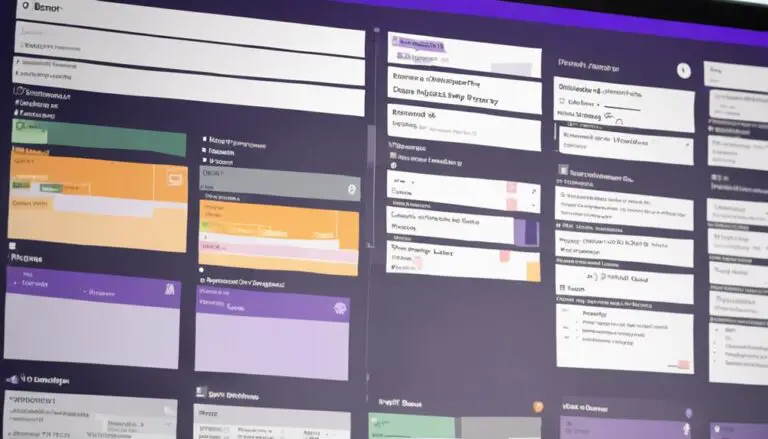In the realm of project management, epics in Kanban serve as the guiding stars, illuminating the path towards project success. By encompassing a broader scope and vision, epics in Kanban set the stage for effective project planning and execution.
Curious to unravel how this strategic use of epics can revolutionize your project management approach and elevate your team's productivity to new heights?
Key Takeaways
- Epics in Kanban provide a big picture view of project goals.
- Breaking down epics enhances efficiency and streamlines project progress.
- Prioritize epics based on strategic importance and project alignment.
- Integrating epics with user stories organizes tasks efficiently.
Definition of Epics in Kanban
In Kanban project management, epics are essential components that capture large bodies of work with a common objective. Think of epics as the big picture view of your project's goals, the overarching themes that guide your team towards success.
These epics are like containers that hold multiple user stories, which are smaller, more detailed tasks that collectively contribute to achieving the epic's objective. However, sometimes these epics can be too vast to tackle all at once, leading to inefficiencies in project management.
This is where the concept of 'Epics Are Broken' comes into play. Breaking down epics into manageable chunks is crucial for ensuring that each part of the epic can be worked on efficiently and effectively. By dividing these large bodies of work into smaller, actionable tasks, you pave the way for smoother progress and better tracking of performance-related tasks within your Kanban project management system.
Breaking Down Epics in Kanban
To enhance efficiency and streamline project progress in Kanban, consider breaking down epics into smaller, actionable tasks that promote smoother workflow and effective tracking. Breaking down epics in Kanban is a crucial step in project management as it allows for better organization, planning, and execution of tasks. By breaking down epics into manageable components, you can ensure that each task is clearly defined, assigned, and completed within a specific timeframe. This approach not only helps in tracking progress more effectively but also enables teams to adapt to changing requirements swiftly.
Different organizations may adopt various strategies for breaking down epics based on their unique needs and project complexities. Whether it's dividing epics by roles, time constraints, or other factors, the key is to ensure that the breakdown aligns with the overall project goals. Efficiently breaking down epics can significantly impact how tasks are prioritized, managed, and ultimately lead to successful project completion. Remember, in Kanban, the devil is in the details, so pay attention to the granularity of your tasks within epics to achieve optimal project management outcomes.
Prioritizing Epics in Kanban
Consider prioritizing epics in Kanban based on their strategic importance and alignment with project goals to ensure efficient project management and resource allocation. Prioritization of epics is a critical step that influences the team's focus and productivity. By assessing factors like impact, complexity, and dependencies, you can determine the order in which epics should be addressed. Weighted Shortest Job First (WSJF) is a technique that can assist in this process by assigning weights to epics based on cost of delay, job size, and other relevant metrics.
Efficient project management hinges on the ability to prioritize epics effectively. This prioritization not only guides the team on what to tackle next but also ensures that the most valuable tasks are given precedence. By aligning epics with overarching project goals, you create a roadmap that leads to successful project outcomes. Remember, the prioritization of epics is a dynamic process that may evolve as project needs change. Stay adaptable and regularly reassess the priority of epics to keep your Kanban workflow streamlined and goal-oriented.
Tracking Epics Progress in Kanban
To effectively track the progress of epics in Kanban, visualize them on the Kanban board and utilize swimlanes for easy monitoring. Epics, represented as swimlanes, provide a clear visual representation of their advancement within the project. By incorporating timeline lanes on team boards, you can further enhance the tracking process, ensuring that epics are progressing as planned.
Additionally, breaking down epics into tasks related to user stories offers a granular approach to monitoring progress, allowing for better insights into the status of each epic.
Utilizing Kanban tools can also streamline the tracking of epics progress. Some tools offer specific features like a Hoshin Board, which serves as a top-level tracking mechanism for themes and initiatives, providing a comprehensive view of how epics align with the overarching project goals.
Integrating Epics With User Stories
Integrating epics with user stories enhances project management by providing a comprehensive framework for organizing and prioritizing tasks efficiently.
Epics, acting as high-level requirements, capture large work volumes in alignment with strategic project goals. Composed of multiple user stories, epics help in breaking down complex tasks into manageable chunks.
This integration not only enhances transparency but also fosters better communication and control over workflow.
Continuous Improvement With Epics in Kanban
Enhance your Kanban project management through continuous improvement with Epics as a structured approach to breaking down large-scale requirements into manageable chunks. By utilizing Epics in your project development, your team can effectively prioritize tasks, enhance transparency, and track progress efficiently. Epics serve as a valuable tool for aligning complex projects with strategic goals, enabling your team to adapt to changes and optimize processes for enhanced performance. Furthermore, incorporating Epics into your Kanban project management process allows for better visibility into the overall scope of work, enabling the team to make more informed decisions and respond to evolving customer needs. This structured approach aligns seamlessly with the principles of Kanban in agile framework, fostering a culture of continuous improvement and adaptability. By embracing Epics as a part of your Kanban project management strategy, your team can maximize productivity and delivery of high-quality results.
Breaking down Epics into smaller user stories allows your team to maintain a steady workflow and deliver incremental value throughout the project lifecycle. This iterative approach not only streamlines project development but also ensures that your team can respond promptly to evolving requirements. By incorporating Epics into your Kanban framework, you empower your team to achieve project objectives effectively while fostering a culture of continuous improvement and collaboration. Embrace the power of Epics to drive success in your Kanban projects and elevate your team's performance to new heights.
Frequently Asked Questions
How Do You Use Epics in Kanban?
When using epics in Kanban, you streamline work by mapping out stories on boards, enhancing your agile approach. Breaking down epics into tasks boosts efficiency, aligning with strategic goals for epic workflow.
How Is Kanban Used in Project Management?
In project management, Kanban helps you prioritize tasks, visualize workflow, limit work in progress, and focus on continuous improvement. Embrace Kanban's efficiency to streamline your projects and enhance collaboration for successful outcomes.
What Are Epics in Project Management?
Epics in project management are large bodies of work, crucial for an agile approach. They enable story mapping within the Scrum framework, aligning strategic objectives with daily tasks. Breaking epics down ensures efficient resource allocation and goal achievement.
How Does Kanban Increase Efficiency?
Boost efficiency with Kanban by breaking tasks into manageable pieces, visualizing workflows for easy tracking, limiting WIP to reduce multitasking, and focusing on completing tasks. Facilitate team collaboration and continuous improvement for optimal results.
Conclusion
As you wrap up your Kanban project using epics, you'll find that the coincidental efficiency and transparency achieved will amaze you.
By breaking down epics, prioritizing tasks, and tracking progress, you'll see a significant impact on your project management success.
Keep integrating epics with user stories and embracing continuous improvement to drive your project towards even greater heights.
Kanban's utilization of epics truly transforms the way you manage and deliver projects.





